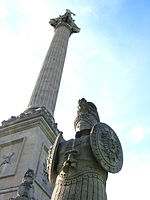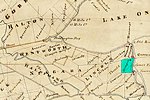Queenston

Queenston is a compact rural community and unincorporated place 5 kilometres (3.1 mi) north of Niagara Falls in the Town of Niagara-on-the-Lake, Ontario, Canada. It is bordered by Highway 405 to the south and the Niagara River to the east; its location at the eponymous Queenston Heights on the Niagara Escarpment led to the establishment of the Queenston Quarry in the area. Across the river and the Canada–US border is the village of Lewiston, New York. The Lewiston-Queenston Bridge links the two communities. This village is at the point where the Niagara River began eroding the Niagara Escarpment. During the ensuing 12,000 years the Falls cut an 11 kilometres (6.8 mi) long gorge in the Escarpment southward to its present-day position.In the early 19th century, the community's name was spelled as Queenstown.Queenston marks the southern terminus of the Bruce Trail. The cairn marking the trail's terminus is in a parking lot, about 160 metres (520 ft) from General Brock's Monument on the easterly side of the monument's park grounds.
Excerpt from the Wikipedia article Queenston (License: CC BY-SA 3.0, Authors, Images).Queenston
Dumfries Street,
Geographical coordinates (GPS) Address Nearby Places Show on map
Geographical coordinates (GPS)
| Latitude | Longitude |
|---|---|
| N 43.165 ° | E -79.055833333333 ° |
Address
Dumfries Street 18
L0S 1L0
Ontario, Canada
Open on Google Maps







